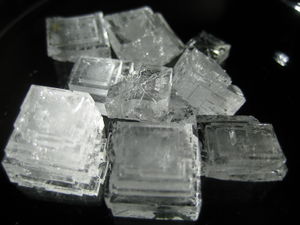Sodium chlorate
 Sodium chlorate crystals
| |
| Names | |
|---|---|
| IUPAC name
Sodium chlorate
| |
| Other names
Asex
Polybor-chlorate Sodium chlorate(V) | |
| Properties | |
| NaClO3 | |
| Molar mass | 106.44 g/mol |
| Appearance | White crystalline solid |
| Odor | Odorless |
| Density | 2.49 g/cm3 (15 °C) 2.54 g/cm3 (20.2 °C) |
| Melting point | 248 °C (478 °F; 521 K) |
| Boiling point | Decomposes |
| 79 g/100 ml (0 °C) 89 g/100 ml (10 °C) 105.7 g/100 ml (25 °C) 125 g/100 ml (40 °C) 220.4 g/100 ml (100 °C) | |
| Solubility | Soluble in glycerol, hydrazine, methanol Slightly soluble in liq. ammonia, ethanol Sparingly soluble in acetone Insoluble in hydrocarbons |
| Solubility in ethanol | 14.7 g/100 g |
| Solubility in ethylene glycol | 16 g/100 g (25 °C) |
| Solubility in glycerol | 20 g/100 g (15.5 °C) |
| Solubility in hydrazine | 66 g/100 g (25 °C) |
| Solubility in methanol | 51.35 g/100 g (25 °C) |
| Vapor pressure | ~ 0 mmHg |
| Thermochemistry | |
| Std molar
entropy (S |
129.7 J·mol-1·K-1 |
| Std enthalpy of
formation (ΔfH |
-365.4 kJ/mol |
| Hazards | |
| Safety data sheet | Sigma-Aldrich |
| Flash point | Non-flammable |
| Lethal dose or concentration (LD, LC): | |
| LD50 (Median dose)
|
6,500 mg/kg (rat, oral) 700 mg/kg (dog, oral) |
| Related compounds | |
| Related compounds
|
Sodium hypochlorite Sodium chlorite Sodium perchlorate |
| Except where otherwise noted, data are given for materials in their standard state (at 25 °C [77 °F], 100 kPa). | |
| Infobox references | |
Sodium chlorate is an inorganic compound, comprised of equal numbers of sodium cations and chlorate anions, giving it the fomula NaClO3. It is a very powerful oxidizer.
Contents
Properties
Chemical
It is a strong oxidizing agent, easily supplying oxygen to combustibles. It decomposes above 300 °C yielding oxygen and sodium chloride.
- 2 NaClO3 → 2 NaCl + 3 O2
Sodium chlorate will react with potassium chloride to precipitate potassium chlorate:
- KCl + NaClO3 → NaCl + KClO3
Physical
Sodium chlorate is a colorless or white crystalline solid with a cubic crystal structure. It is soluble in water, methanol, glycerol, hydrazine and slightly soluble in ethanol and ammonia. Because sodium chlorate is hygroscopic, potassium chlorate is often preferred for use as an oxidizer.
Sodium chlorate crystals are chiral, and both enantiomorphic (R/L) forms crystallize from solution in roughly equal proportions. Seeding with a selected enantiomorphic form leads to enrichment in that form. The presence of D-glucose or other chiral sugars skews the proportion of the two forms during crystallization. This is only a solid state effect due to the crystal structure, and in solution no enantiomers or optical activity can be observed. Big crystals can be sorted by hand using polarizing filters into their respective enantiomorphs.[1]
Availability
It can be bought as "weed killer" at a hardware store, or it can be bought online. Some brands may be adulterated with sodium chloride; in this case, the weed killer cannot be used as a reagent as is, but can be used as a raw material to prepare potassium chlorate. Many countries, however, have banned sodium chlorate weed killers.
Its sale is banned in the EU.
Preparation
Sodium chlorate can be produced by boiling bleach, which causes it to disproportionate into sodium chlorate and sodium chloride.
A more efficient way of producing sodium chlorate is via the electrolysis of a supersaturated sodium chloride solution with an appropriate anode at ~5 volts DC.
Although the exact reactions are very complex, the basic overall equation is:
- NaCl + 3 H2O → NaClO3 + 3 H2
Projects
- Preparation of potassium chlorate
- Make a dry chemical oxygen generator: Heat is generated by oxidation of a small amount of iron powder mixed with the sodium chlorate, and the reaction consumes less oxygen than is produced. Barium peroxide is used to absorb the chlorine which is a minor product in the decomposition.[2] An ignitor charge is activated by pulling on the emergency mask. Similarly, the Solidox welding system used pellets of sodium chlorate mixed with combustible fibers to generate oxygen.
Handling
Safety
Powerful oxidizer! Fire hazard! Keep away from any flammables.
Due to its oxidative nature, sodium chlorate can be very toxic if ingested. The oxidative effect on hemoglobin leads to methaemoglobin formation, which is followed by denaturation of the globin protein and a cross-linking of erythrocytemembrane proteins with resultant damage to the membrane enzymes. This leads to increased permeability of the membrane, and severe hemolysis. The denaturation of hemoglobin overwhelms the capacity of the G6PD metabolic pathway. In addition, this enzyme is directly denatured by chlorate reducing its activity.
Avoid contact with concentrated acids like sulfuric acid due to formation of highly reactive chloric acid.
Storage
Sodium chlorate should be stored in closed bottles, away from any flammable materials and strong acids. Since it's hygroscopic, it should be kept in a dry place.
Disposal
Sodium chlorate can be neutralized with acidified sodium or potassium metabisulfite.
Gallery
References
- ↑ Gmelins Handbuch der anorganischen Chemie, Natrium, Verlag Chemie GmbH, Berlin, 8th edition 1928, p. 401
- ↑ http://en.wikipedia.org/wiki/Sodium_chlorate#cite_note-8
